|
Many
years ago a young man left his native country in an age of innocence.
Exchanging the security of an ordered (though in the long run perhaps
somewhat confining) welfare state, for the zest and vitality of
a vast and complex country in the West. The young man's name was
Bertil Vallien and it is about the years he spent in the US, 1961-3
that is the focus of this article. A rosy era long since faded into
the horizon.
-Well,
I remember it as a blend of hopeful anticipation, joy and fear.
The fear of not being good enough, not being able to make a living
out of the lengthy training I'd had. But mostly of tremendous optimism.
I needed a job - and I knew that I could get one. But how would
I cope with it? Bertil searches his memory.
His fears,
though a mark of humility, were unfounded. Wasn't he that student
in the ceramics department at the Konstfack college, 1955-61, who
had thrown himself into a frenzy of creativeness, bursting with
energy, and totally dedicated to becoming the best student they'd
ever had?
In summer
'59, he was drawn into the world of glass. More precisely to the
studio of Erik Höglund (distinguished Swedish glass artist)
at Boda, for a spell of training. "It was a dream situation
for all of us young potters. Not least because of his great personality;
his ability to inspire and to open new doors. He was a living proof
that elegance in a design wasn't everything." Höglund
engaged Bertil as an assistant, 1959-60.
-For some reason he didn't want me as a designer at Boda, so he
arranged a place for me at Åfors in 1960, where I loaned Ernest
Gordon's studio for one month. I designed my very first glass service
- a set of blue glasses, titled BV 101.
He would
return to this studio many times. After completing his education
(with honours) at the college in 1961, he took up an offer of employment
from the Hal Framholdt Ceramics company in Los Angeles. And in September,
armed with a Royal scholarship, he set sail, crossing the Atlantic
on the SS Gripsholm. (The journey lasted a week and a one-way passage
cost 1,100 Swedish kronor). He had a great time on board, dining
in style and celebrating with other young scholarship holders. In
New York he boarded the plane to LA.
What
were his first impressions of Los Angeles?
-I was
dumbstruck! Says Bertil . All those orange groves, swimming pools
and automobiles in a sweltering hot city. One particular memory
is a spicy detail. Hal Framholdt met me at the airport. I was quite
tired after the long journey so he suggests that we go and rest.
It turns out that we're gonna be in the same bed. (I'd read somewhere
that one shouldn't be surprised if American friends invited one
to share a bed!) Well OK then, that's the way they do it here, I
thought. So I climb in beside him. Only to discover that he was
after my body! He was a renowned homosexual. That night I slept
in an armchair. It wasn't a good beginning...for him. I soon got
hold of an apartment in Bunker Hill, downtown. The glass factory
was within walking distance.
The sixties
was a dynamic period for the American arts and crafts, especially
in California, where people like Peter Voulkos and Jerry Rothman,
were breaking with the traditional methods of working with clay.
"I wasn't into glass at that time", Bertil admits. Along
with glass and pottery, there was Pop Art and the happy-go-lucky
music that made up the soundtrack of the Kennedy era: Frank Sinatra,
The Beach Boys and the Pop symphonies of Phil Spector.
-The
US was a real injection, and a terrific boost to my self confidence.
Instead of spending hours on the spout of a jug (as I had done at
the college) I was able to work on my own ideas, but to begin with
I had to do a lot of boring jobs. Before long, I was making models,
which were rapidly put into production, The factory's basic range
consisted of ash trays, murals, and large (stoneware) jars. Hal
was really quite a remarkable person. He believed in the supernatural,
and would insist that every firing at the kiln was presided over
by a guardian spirit, or household god. It was my job to make these
clay figurines, which eventually became part of the production line.
Hal died in 1975 - of unknown causes. But it's my guess that he
was one of the first AIDS cases. Before anyone was aware of the
dreadful disease.
The bold
optimism of the sixties spurred Bertil to reject the dominant style
of contemporary Swedish design.
-I was
really pissed off by Scandinavian Design.
He quickly
acquired a network of contacts, among fellow artists and art-galleries.
The first
real test for Bertil took place at the Ryder Gallery (on La Cinega
Boulevard), in June, 1962. Just two blocks away, another opening-day
was in progress.
-Imagine.
Me and Andy Warhol having a show at the same time! That was when
he exhibited his soup cans for the first time.
Bertil
holds his first one-man show at which he exhibits some forty sculptures.
He sells every one of them and even got a good press.
Art
professor, Karl With, wrote the following, (translated from Gunnar
Lindqvist's Swedish text):
"...but
what a wonderful surprise to witness such technical mastery, expressive
vitality and powerful fancy. Vallien's sense for native folk tradition
is so fresh and instinctive as to allow an easy translation into
the artistic idiom of our time-"
In spring
1962, Bertil had won the "Young Americans 1962"award at
the Museum of Contemporary Crafts in New York, for his sculpture
"Family on Whale". The fact that the prize-winner was
a young Swede with an American sounding name, had caused a mild
sensation. Or how does the story go?
-When
I left college my name was Wallin, but in LA I discovered that there
was a actually another Swede - a silversmith - with the same surname,
so I changed mine to Vallien. Presumably the jury liked my work,
and I don't think there was anything political in their decision.
Of course, I was glad, but at the same time it didn't strike me
as so remarkable. Recently I was talking to an American professor
of sculpture ( my age) who remembers the talk: "Is it true
that a Swede is to get it?" Strangely enough, I felt like an
American - the good thing about the States is that you can't be
identified by your name. You can be called Ching Chong, Abdullah
Muhammed or Bertil Vallien and still call yourself American.
The triumphs
continued. In October he won another prize - a shared first (plus
175 dollars) from the Emerson
Museum of Art , for his sculpture "Bull Mountain".
In February 1963 he held a second exhibition at the Ryder Gallery,
selling work for over 2,000 dollars. Although he brought no ceramic
work back to Sweden; he did bring a freer way of working with clay
- action pottery.
As he stated in the DN (Daily News June 4, 1963): "...the main
emphasis (in this 'free school') is on the properties of clay, and
how it behaves; there's no question of disciplining it on a wheel."
The following month he returned to Sweden. **
The sculpture,
"Family on Whale" is, he believes, now in the possession
of some big art collector. He is often approached by people who
say that they bought a work of his at Ryder's. But true or not,
no ceramics from that period have survived. During his last year
in Los Angeles he was joined by Ulrica and together they travelled
to Mexico, a culture that has fired his imagination ever since college
days. Notwithstanding his many triumphs, Bertil decides to return
to Sweden.
-Sometimes
I thought I might stay in America, but there was a real incentive
to go back, since I'd been offered a good job at the glass factory
in Åfors. "OK, I'll try it, I thought; I can always come
back here if it doesn't work out". I throw out a hypothetical
question: how would his art have developed if he had stayed in the
States?
-I wouldn't have worked with glass. Most likely I'd have become
a professor with my own studio. But what do I know?
The years I spent in the US have meant a lot to me. The tremendous
vitality and desire to do things in a big way, (which can also have
dire consequences!). It was a real kick!
He has
derived enduring pleasure from his years in America; and an intimate
knowledge of American society. He still maintains contact with various
people over there. The forces of chance, or destiny, or whatever,
may lead one on many journeys. But individual forces, or powers,
are often overlooked.
BV began his forceful journey at the top and there he has remained.
|
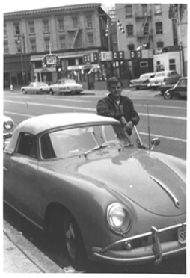
Bertil
Vallien ready to drive Hal Fromhold´s Porsche somewhere in
LA.
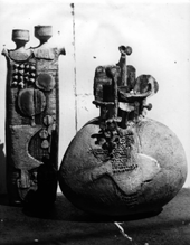
On
the right: "Family On Whale", 1962.
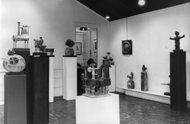
Bertil´s
first one-man-show with ceramics at Ryder Gallery, 1962.
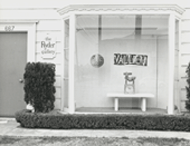
Outside
Ryder Gallery, 1962.
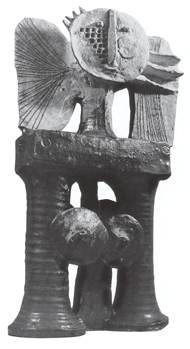
An
owl in stoneware.
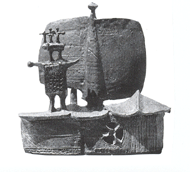
Bertil
Vallien´s first boatsculpture.
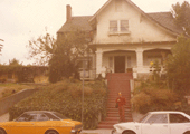
Bertil
in front of the house in Bunker Hill, LA. The photo was taken in
beginning of the 70s.
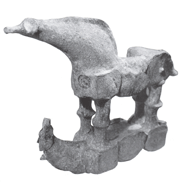
A
horsesculpture in stoneware.
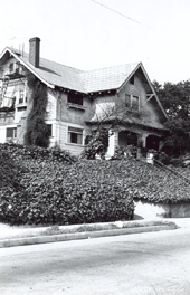
Bertil
lived in this house at the second floor. The photo was taken during
is years in LA (1961-63).
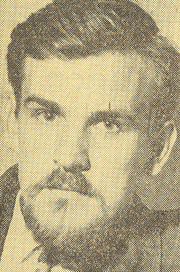
This
picture is taken from an article on the US ceramicscene (4/6/63)
in Sweden´s leading newspaper, Dagens Nyheter (Daily News)
|


